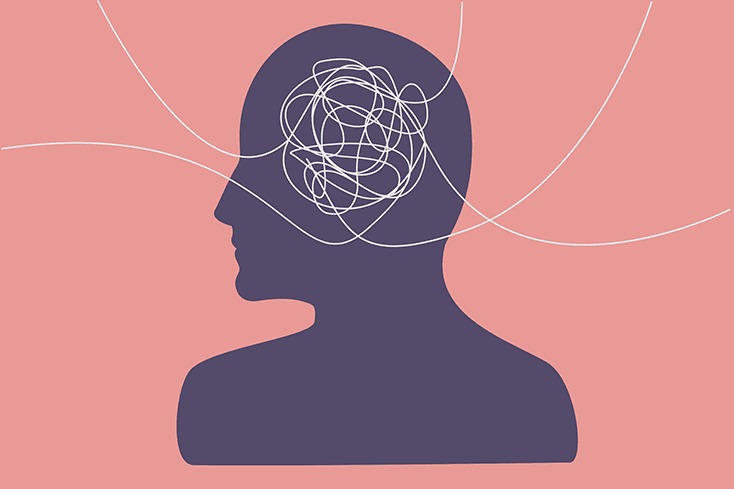February 01, 2023
By Jason Jepson

Perhaps the most important milestone in my schizophrenia recovery — acceptance — happened after I was hospitalized and placed in temporary housing. I was taking steps to eventually live on my own again. I was beginning to feel clearer, and the medication I was prescribed started to take hold. Gradually my symptoms started to subside. I accepted that my doctors were correct, and I did, in fact, have schizophrenia.
With this clarity, I could better understand schizophrenia was a serious mental illness, and its symptoms of delusions and hearing voices might not go away entirely. But I wanted to learn as much as I could about this condition and its manifestations. So, I began to make a checklist of my symptoms. To this day, I still take this list to all my therapy sessions and medical appointments.
Writing down (and checking off) the different challenges I experience in between appointments has helped me tell my doctors exactly what was going on in my everyday life with schizophrenia. And, more importantly, it has helped me to differentiate what is real and what is a symptom. My checklist includes the following:
I will hear voices in my head describing the mundane actions I take. “They are like ‘he is watching tv,’ or ‘he’s getting his mail,’” I once told my therapist.
My therapist understood perfectly and described this kind of symptom as “commentary.”
I felt validated by this labeling of my symptom and walked back to my car smiling. My delusions, hallucinations and voices would just blow around in my head like a twister, and it helped to identify what, exactly, was happening. Now, I know that if I hear this kind of voice, it has a label and is a part of my schizophrenia checklist.
Through my own research, I learned there was a name for one of my other symptoms: “thought broadcasting.” I remembered my time in the Mojave Desert where I was stationed in the Army. At the time, I believed I had special powers; when my fellow soldiers or others made eye contact with me, I believed we could communicate with our minds. Essentially, I believed that other people could see, hear and feel my thoughts. This became another type of symptom to include in my checklist.
Now, when I experience thought broadcasting in a public place like a restaurant or grocery store, I can feel confident that this is just another symptom and not my reality. This certainty helps me to ignore my often-distracting voices and beliefs.
A similar symptom I experienced in the Mojave Desert (and in the early stages of schizophrenia) was thinking that eye contact with women allowed them to be romantically connected to me and my thoughts. I could feel a warmness in my chest, and I thought it was their heart. This is another version of thought broadcasting I note on my checklist.
Sometimes when I look out into the parking lot of my apartment, I might see a car I do not recognize. Are they there for me? Are they stalking me? I wonder. In the moment, that concern feels real. What do they want? Do they want me to come out and talk to them? Now that my therapist and I have identified this as a paranoid delusion, I know that when I am experiencing this type of thinking, I shouldn’t react, and instead, should try to distract myself. Often, if I can go back to watching television, I can block out this line of thought. And, like my other symptoms, it goes on the checklist.
Of course, one of the greatest challenges of living with schizophrenia is determining what is real. Educating myself about serious mental illness and its symptoms has been a critical tool in addressing this challenge. Now I know that schizophrenia has identifiable symptoms, I can refer to my check list when I am unsure about my reality. Of course, this method isn’t perfect. Sometimes, I may not recognize something as a symptom until the next day when I’ve had time to process the situation. But having a checklist, combined with appropriate medication and therapy, empowers me to better understand myself and the world around me. I will always have my diagnosis, but I am able to understand and manage my symptoms.
Jason Jepson grew up in Virginia, but he now lives in Myrtle Beach, S.C., where he advocates for those who have received a diagnosis of severe mental illness. Jason was diagnosed with schizoaffective disorder while he was enlisted in the U.S. Army. He began his mental health advocacy with NAMI, where he received peer-to-peer certification, and he has since gone on to volunteer helping veterans who have mental health issues.
Note: A version of this article was originally published in The Schizophrenia Bulletin. It has been edited and reprinted with permission.
We’re always accepting submissions to the NAMI Blog! We feature the latest research, stories of recovery, ways to end stigma and strategies for living well with mental illness. Most importantly: We feature your voices.
LEARN MORENAMI HelpLine is available M-F, 10 a.m. – 10 p.m. ET. Call 800-950-6264,
text “helpline” to 62640, or chat online. In a crisis, call or text 988 (24/7).